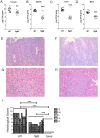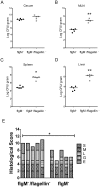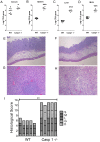Innate immune detection of flagellin positively and negatively regulates salmonella infection
- PMID: 23977202
- PMCID: PMC3747147
- DOI: 10.1371/journal.pone.0072047
Innate immune detection of flagellin positively and negatively regulates salmonella infection
Abstract
Salmonella enterica serovar Typhimurium is a flagellated bacterium and one of the leading causes of gastroenteritis in humans. Bacterial flagellin is required for motility and also a prime target of the innate immune system. Innate immune recognition of flagellin is mediated by at least two independent pathways, TLR5 and Naip5-Naip6/NlrC4/Caspase-1. The functional significance of each of the two independent flagellin recognition systems for host defense against wild type Salmonella infection is complex, and innate immune detection of flagellin contributes to both protection and susceptibility. We hypothesized that efficient modulation of flagellin expression in vivo permits Salmonella to evade innate immune detection and limit the functional role of flagellin-specific host innate defenses. To test this hypothesis, we used Salmonella deficient in the anti-sigma factor flgM, which overproduce flagella and are attenuated in vivo. In this study we demonstrate that flagellin recognition by the innate immune system is responsible for the attenuation of flgM(-) S. Typhimurium, and dissect the contribution of each flagellin recognition pathway to bacterial clearance and inflammation. We demonstrate that caspase-1 controls mucosal and systemic infection of flgM(-) S. Typhimurium, and also limits intestinal inflammation and injury. In contrast, TLR5 paradoxically promotes bacterial colonization in the cecum and systemic infection, but attenuates intestinal inflammation. Our results indicate that Salmonella evasion of caspase-1 dependent flagellin recognition is critical for establishing infection and that evasion of TLR5 and caspase-1 dependent flagellin recognition helps Salmonella induce intestinal inflammation and establish a niche in the inflamed gut.
Conflict of interest statement
Figures








References
-
- Janeway CA Jr (1989) Approaching the asymptote? Evolution and revolution in immunology. Cold Spring Harb Symp Quant Biol 54 Pt 1: 1–13. - PubMed
-
- Stecher B, Hardt WD (2008) The role of microbiota in infectious disease. Trends Microbiol 16: 107–114. - PubMed
-
- Miao EA, Alpuche-Aranda CM, Dors M, Clark AE, Bader MW, et al. (2006) Cytoplasmic flagellin activates caspase-1 and secretion of interleukin 1beta via Ipaf. Nat Immunol 7: 569–575. - PubMed
Publication types
MeSH terms
Substances
Grants and funding
LinkOut - more resources
Full Text Sources
Other Literature Sources
Medical
Molecular Biology Databases

